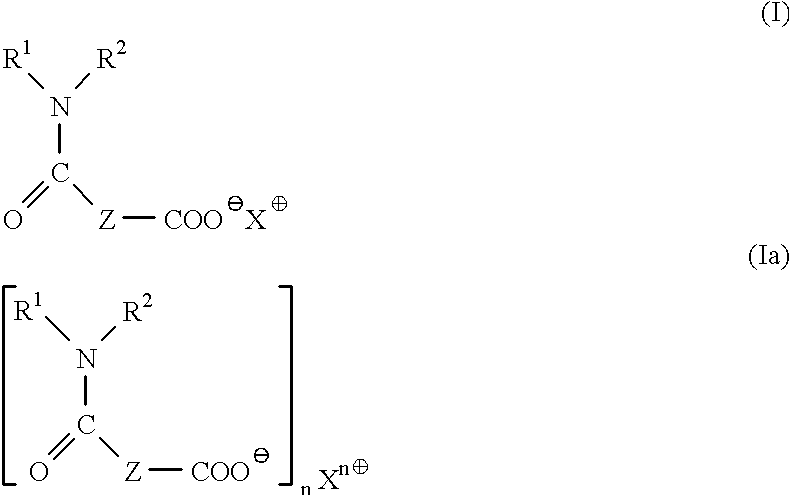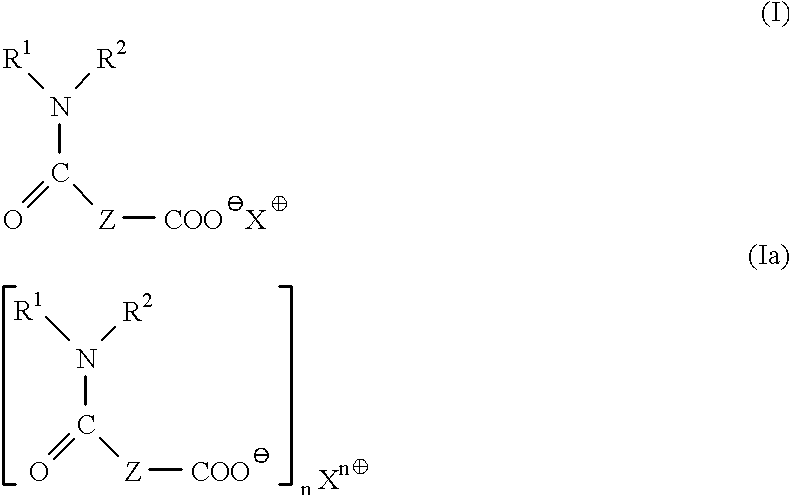Method for the determination of lipase
a technology of lipase and determination method, which is applied in the field of lipase determination method, can solve the problems of reproducible production, unspecified reaction, and low accuracy of the method, and achieve the effect of reducing unspecified reaction and increasing the validity of the analytical resul
- Summary
- Abstract
- Description
- Claims
- Application Information
AI Technical Summary
Benefits of technology
Problems solved by technology
Method used
Image
Examples
example 2
Various concentrations of the additive according to the invention (interference eliminating agent)
The reagent composition for the lipase colour test corresponds to the reagents R1 and R2 stated in example 1 except that R1 additionally contains 0.27% of a mixture of tetrasodium-N-(1,2dicarboxyethyl)-N-alkyl-sulfosuccinamide with a C12 to C18 alkyl residue.
Samples: NaCl with various concentrations of IgG (0-3 g / l).
The colour test is carried out and evaluated on a BM / Hitachi 717 automated analyzer according to the application and details described in example 1.
Result: At the predetermined concentrations an unspecific non-enzymatic hydrolysis is eliminated (cf. FIG. 2).
example 3
Preparation of the complete reagent
Regant 1: as described in example 1
Reagent 2:
0.6 g lipase colour substrate (e.g. 1,2-O-dilauryl-rac-glycero-3-glutaric acid-(6'-methyl resorufin)ester) are solved in 9 ml of a suitable alcohol, e.g. ethanol. 1 g of a emulgator, e.g. Brij 35 or Triton X-114, is added to the solution. The resulting oelic phase is soaked up in an injection needle and pressed under high pressure through a thin cannula (inner diameter 0,15 to 1,0 mm) into an aqueous solution which is stirred at the same moment. The aqueous solution comprises, e.g., 0.15 g tartrate buffer (pH 5,0), 0.009 g calcium chloride and 0.5 g taurodeoxycholate solubilized in 100 ml water. It is possible that the aqueous solution contains in addition one or more preservative and any further auxiliary emulgator components.
example 4
Comparison of the turbidimetric method / colour test without the addition of a substance according to the invention.
The reagent composition of the lipase colour test corresponds to the details described in example 1.
The reagent composition of the "lipase turbidimetric test" is as follows:
R1: 19.0 mmol / l sodium deoxycholate
26.0 mmol / l Tris buffer
3.0 mg / ml colipase
0.30 mmol / l triolein preservative
Samples: human sera
The various lipase determinations are carried out on a BM / Hitachi 717 automated analyzer according to the following application:
The evaluation is carried out analogously to example 1.
Result: The method comparison shows that colour tests exhibit an axis intercept which is due to the unspecific hydrolysis of the colour substrate by serum components (cf. FIG. 3).
PUM
| Property | Measurement | Unit |
|---|---|---|
| pH | aaaaa | aaaaa |
| concentration | aaaaa | aaaaa |
| pH | aaaaa | aaaaa |
Abstract
Description
Claims
Application Information
 Login to View More
Login to View More - R&D
- Intellectual Property
- Life Sciences
- Materials
- Tech Scout
- Unparalleled Data Quality
- Higher Quality Content
- 60% Fewer Hallucinations
Browse by: Latest US Patents, China's latest patents, Technical Efficacy Thesaurus, Application Domain, Technology Topic, Popular Technical Reports.
© 2025 PatSnap. All rights reserved.Legal|Privacy policy|Modern Slavery Act Transparency Statement|Sitemap|About US| Contact US: help@patsnap.com



